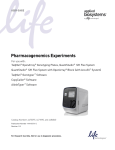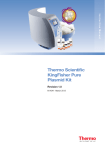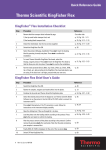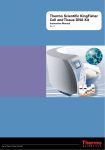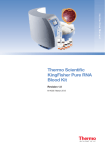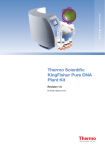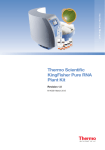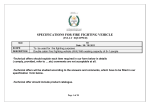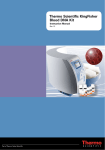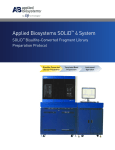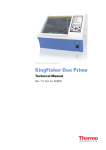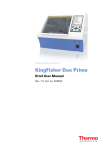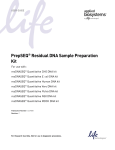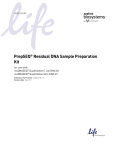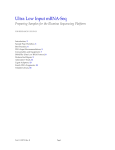Download MagMAX™ DNA Multi-Sample Ultra Kit (blood cards) User Guide
Transcript
USER GUIDE MagMAX™ DNA Multi-Sample Ultra Kit High-throughput isolation of PCR-ready DNA from blood cards Catalog Number A25597 and A25598 Pub. No. MAN0010816 Rev. A.0 WARNING! Read the Safety Data Sheets (SDSs) and follow the handling instructions. Wear appropriate protective eyewear, clothing, and gloves. Safety Data Sheets (SDSs) are available from www.lifetechnologies.com/support. Product information The MagMAX™ DNA Multi-Sample Ultra Kit is designed for rapid, high-throughput isolation of high-quality genomic DNA from a variety of sample matrices. The kit uses MagMAX™ magnetic bead technology, ensuring reproducible recovery of PCR-ready DNA suitable for a broad range of applications, such as SNP genotyping and copy number experiments. This protocol describes isolation of DNA from mammalian whole blood spotted onto blood storage cards, optimized for use with the MagMAX™ Express-96 Deep Well Magnetic Particle Processor or with the KingFisher™ Flex Magnetic Particle Processor (96-well deep well setting). The typical DNA yield obtained from 3-mm2 sections of card spotted with 40 µL of blood is 50–200 ng at a 0.5–2 ng/µL concentration. Kit contents and storage Cat. no. A25598 (500 rxns) (2500 rxns) Proteinase K[1] 4 mL 5 × 4 mL PK Buffer 96 mL 5 × 96 mL Multi-Sample DNA Lysis Buffer RNase A 100 mL 5 × 100 mL Storage –15°C to –25°C 15°C to 30°C 8 mL 5 × 8 mL 2°C to 8°C Nuclease-free Water 100 mL 5 × 100 mL Wash Solution 1 Concentrate 80 mL[2] 5 × 80 mL[2] 162 mL[2] 5 × 162 mL[2] DNA Elution Buffer 1 25 mL 5 × 25 mL DNA Elution Buffer 2 25 mL 5 × 25 mL [2] KingFisher™ Flex Magnetic Particle Processor[1] Thermo Scientific Cat. no. 5400630 Equipment Thermo Scientific™ Titer Plate Shaker Cat. no. 14-271-9[2] One of the following incubators, or an equivalent incubator with slatted shelves and thermometer: Economy Lab Incubator Cat. no. S50441A[2] VWR® Digital Mini Incubator VWR Cat. no. 10055-006 Fisher Scientific™ Analog Vortex Mixer Adjustable micropipettors Multi-channel micropipettors Cat. no. 02-215-365[2] MLS MLS Cat. no. AM10027 Scalpel or hole puncher MLS Forceps MLS MagMAX™ Express-96 Deep Well Plates Cat. no. 4388476 MagMAX Express-96 Standard Plates Cat. no. 4388475 MagMAX™ Express-96 Deep Well Tip Combs Cat. no. 4388487 MicroAmp Clear Adhesive Film Cat. no. 4306311 ® –15°C to –25°C [1] Cat. no. 4400077 ™ 10 × 1.25 mL Wash Solution 2 Concentrate MagMAX™ Express-96 Magnetic Particle Processor Plastics and consumables 2 × 1.25 mL DNA Binding Beads[1] Source Magnetic particle processor (Optional but recommended) Magnetic Stand-96 Cat. no. A25597 Component Item 15°C to 30°C Proteinase K is also available as Cat. no. A25561 and DNA Binding Beads are also available as Cat. no. A25562. Final volume; see “Before first use of the kit: prepare Wash Solutions” on page 2. Materials required but not supplied Unless otherwise specified, all materials are available from Life Technologies. MLS: major laboratory supplier. For Research Use Only. Not for use in diagnostic procedures. Whatman FTA Elute Cards, or equivalent ® ® MLS RNase-free Microfuge Tubes (2.0 mL) Cat. no. AM12425 Conical tubes (15 mL) Cat. no. AM12500 Conical tubes (50 mL) Cat. no. AM12502 Aerosol-resistant pipette tips MLS Reagent reservoirs MLS Reagents Ethanol, 200 proof (absolute) MLS Isopropanol, 100% (molecular grade or higher) MLS NaCl (5M) Cat. no. AM9760G EDTA (0.5M), pH 8.0 Cat. no. AM9260G [1] [2] See “If needed, download the KingFisherDZ Flex program” on page 2. Available from Fisher Scientific Sample collection and storage • 1. Collect 40 µL of blood samples onto Whatman® FTA® Elute Cards using one of the following methods. Note: A different collection volume might be needed for other types of blood cards. • Finger stick: Collect samples directly on the blood cards. • Venipuncture: Collect samples in EDTA or sodium citrate anticoagulant tubes, then transfer to blood cards. Note: Heparin is not recommended as an anti-coagulant since it can cause inhibition of PCR reactions. 2. Dry the cards at least 4 hours or according to the manufacturer's instructions; lay flat and protect from moisture. 3. Process samples shortly after they are completely dry, or store the cards in a dry place at room temperature. Important procedural guidelines • • • • • Perform all steps at room temperature (20–25°C) unless otherwise noted. When mixing samples by pipetting up and down, avoid creating bubbles. Use sterile scalpels or hole punchers, and sterile forceps when preparing samples. Dip them in 70% ethanol between each sample to prevent cross-contamination. Cover the plate during the incubation and shaking steps to prevent spill-over and cross-contamination. The same MicroAmp® Clear Adhesive Film can be used throughout the procedure, unless it becomes contaminated. If you use a plate shaker other than the Thermo Scientific™ Titer Plate Shaker, verify that: – The plate fits securely on your titer plate shaker. – The recommended speeds are compatible with your titer plate shaker. Ideal speeds should allow for thorough mixing without splashing. Per-plate volumes for reagent mixes are sufficient for one plate plus overage. To calculate volumes for other sample numbers, refer to the per-well volume and add 5% overage. If needed, download the KingFisher™ Flex program The program required for this protocol is not pre-installed on the KingFisher™ Flex Magnetic Particle Processor. 1. On the MagMAX™ DNA Multi-Sample Ultra Kit web page, scroll down to the Product Literature section. 2. Right-click A25597_Blood_Buccal and select Save as Target to download to your computer. 3. Refer to Thermo Scientific™ KingFisher™ Flex User Manual (Cat. no. N07669) and BindIt™ Software User Manual (Cat. no. N07974) for instructions for installing the program on the instrument. Before first use of the kit: prepare Wash Solutions 1. Prepare the Wash Solutions from the concentrates: • Add 25 mL of isopropanol to Wash Solution 1 Concentrate, mix, and store at room temperature. • Add 132 mL of ethanol to Wash Solution 2 Concentrate, mix, and store at room temperature. 2. Prepare High Salt Wash Solution as indicated in the following table, mix, and store at room temperature Component Volume 5 M NaCl 0.5 M EDTA, pH 8.0 Ethanol Water Total High Salt Wash Solution Final concentration 40 mL 2M 4 µL 2 mM 40 mL 40% (v/v) up to 100 mL — 100 mL — Perform DNA extraction and elution 1 Digest the samples with Proteinase K a. Preheat an incubator to 65°C. b. Prepare sufficient PK Mix according to the following table. Invert PK Mix several times to thoroughly mix components. IMPORTANT! Prepare the PK Mix just before use. Do not place PK Buffer or PK Mix on ice, to avoid precipitation. Component Volume per well Volume per plate 8 µL 800 µL PK Buffer 192 µL 19.2 mL Total PK Mix 200 µL 20 mL Proteinase K c. Add 200 µL of PK Mix to each sample well of a MagMAX Express-96 Deep Well Plate (PK Plate). d. Cut out 1 or 2 pieces of the blood cards, 2–3 mm2 each, using a scalpel or a hole puncher, and transfer them to the appropriate wells of the PK Plate using forceps. ™ IMPORTANT! Ensure that the card pieces are entirely submersed in liquid before starting PK digestion. e. Seal the plate with a MicroAmp® Clear Adhesive Film and shake the sealed plate for 10 minutes at speed 8. f. Incubate overnight at 65°C, then shake the sealed plate for 5 minutes at speed 8. IMPORTANT! Arrange plates in the incubator to allow adequate flow around the plate wells, to ensure that samples quickly reach and maintain the incubation temperature. 2 2 Set up the processing plates Just before the 65°C incubation is complete, set up the Wash, Elution, and Tip Comb Plates outside the instrument as described in the following table. MagMAX™ DNA Multi-Sample Ultra Kit (blood cards) User Guide 2 Set up the processing plates (continued) Table 1 Processing plates Plate ID Plate position[1] 3 Add Multi-Sample DNA Lysis Buffer, Bead/ RNase Mix, and isopropanol Volume per well Wash Plate 1 2 Deep Well Wash Solution 1 150 µL 3 Deep Well High Salt Wash Solution 150 µL Wash Plate 3 4 Deep Well Wash Solution 2 150 µL 5 Standard DNA Elution Buffer 1 50 µL Deep Well Place a MagMAX™ Express-96 Deep Well Tip Comb in a MagMAX™ Express-96 Deep Well Plate. Plate[2] Tip Comb [2] Reagent Wash Plate 2 Elution [1] Plate type 6 Position on the instrument The instrument prompts the user to add DNA Elution Buffer 2 to the Elution Plate, after incubation with DNA Elution Buffer 1. a. (Optional) If condensation is present at the end of the agitation, centrifuge the plate for 1–2 minutes at 1500 × g. b. Transfer samples to the wells of a new MagMAX™ Express-96 Deep Well Plate and discard the previous plate. c. Add 200 µL of Multi-Sample DNA Lysis Buffer to each sample. d. Seal the plate with the MicroAmp® Clear Adhesive Film and shake for 5 minutes at speed 8. e. Prepare Bead/RNase Mix according to the following table. IMPORTANT! Prepare the Bead/RNase Mix up to 20 minutes before use. Prolonged storage at room temperature can reduce its efficiency. Vortex the DNA Binding Beads at moderate speed to form a uniform suspension before pipetting. Component Volume per well Volume per plate DNA Binding Beads 16 µL 1.6 mL RNase A 5 µL 500 µL Nuclease-free Water 19 µL 1.9 mL Total Bead/RNase Mix 40 µL 4 mL f. Vortex the Bead/RNase Mix at moderate speed to ensure thorough mixing and add 40 µL to each sample, then use a multi-channel micropipettor to mix by pipetting up and down 5 times. g. Seal the plate with the MicroAmp® Clear Adhesive Film and shake for 5 minutes at speed 8. h. Add 240 µL of isopropanol to each sample, and proceed immediately to DNA isolation (next step). 4 Wash the beads and elute the DNA a. Select the program on the instrument. • 4413021 DW blood on MagMAX™ Express-96 Magnetic Particle Processor • A25597_Blood_Buccal on KingFisher™ Flex Magnetic Particle Processor b. Start the run and load the prepared processing plates to their positions when prompted by the instrument (see Table 1). c. Load the PK plate (containing lysate, isopropanol, and Bead/RNase Mix) at position 1 when prompted by the instrument. d. When prompted by the instrument (approximately 28–30 minutes after initial start): 1. Remove the Elution Plate from the instrument. 2. Add 50 µL of DNA Elution Buffer 2 to each sample well. IMPORTANT! Add DNA Elution Buffer 2 immediately after the prompt to prevent excessive drying of any beads that are still captured on the Tip Comb. 3. Load the Elution Plate back onto the instrument, and press Start. e. At the end of the run (approximately 30–35 minutes after initial start), remove the Elution Plate from the instrument and seal immediately with a new MicroAmp® Clear Adhesive Film. • If precipitated DNA is visible, pipet up and down 5–10 times before sealing the plate, to ensure complete resuspension. • (Optional) Eluates can be transferred to a storage plate after collection. MagMAX™ DNA Multi-Sample Ultra Kit (blood cards) User Guide 3 4 Wash the beads and elute the DNA (continued) • If excess bead residue is seen in the wells, place the Elution Plate on the Magnetic Stand-96 to capture any residue prior to downstream use of the DNA. IMPORTANT! Do not allow the purified samples to sit uncovered at room temperature for more than 10 minutes, to prevent evaporation and contamination. The purified samples are ready for immediate use. Alternatively, store the covered Elution Plate: • At 2–6°C for up to 24 hours. • At –20°C or –80°C for long-term storage. Recommended quantitation methods Standard curve analysis is the most accurate quantitation method. Use the TaqMan® RNase P Copy Number Reference Assay (Cat. no. 4403326) for human genomic DNA and the TaqMan® DNA Template Reagents (Cat. no. 401970) to create a standard curve. Refer to Creating Standard Curves with Genomic DNA or Plasmid DNA Templates for Use in Quantitative PCR (Pub. no. 4371090). Note: Mix the samples by pipetting up and down before quantitation if they have been stored frozen. Revision history Revision A.0 Date Description September 2014 New document Limited product warranty Life Technologies Corporation and/or its affiliate(s) warrant their products as set forth in the Life Technologies' General Terms and Conditions of Sale found on Life Technologies' website at www.lifetechnologies.com/termsandconditions. If you have any questions, please contact Life Technologies at www.lifetechnologies.com/support. The information in this guide is subject to change without notice. DISCLAIMER LIFE TECHNOLOGIES CORPORATION AND/OR ITS AFFILIATE(S) DISCLAIM ALL WARRANTIES WITH RESPECT TO THIS DOCUMENT, EXPRESSED OR IMPLIED, INCLUDING BUT NOT LIMITED TO THOSE OF MERCHANTABILITY, FITNESS FOR A PARTICULAR PURPOSE, OR NON-INFRINGEMENT. TO THE EXTENT ALLOWED BY LAW, IN NO EVENT SHALL LIFE TECHNOLOGIES AND/OR ITS AFFILIATE(S) BE LIABLE, WHETHER IN CONTRACT, TORT, WARRANTY, OR UNDER ANY STATUTE OR ON ANY OTHER BASIS FOR SPECIAL, INCIDENTAL, INDIRECT, PUNITIVE, MULTIPLE OR CONSEQUENTIAL DAMAGES IN CONNECTION WITH OR ARISING FROM THIS DOCUMENT, INCLUDING BUT NOT LIMITED TO THE USE THEREOF. Important Licensing Information: This product may be covered by one or more Limited Use Label Licenses. By use of this product, you accept the terms and conditions of all applicable Limited Use Label Licenses. ©2014 Thermo Fisher Scientific Inc. All rights reserved. All trademarks are the property of Thermo Fisher Scientific and its subsidiaries unless otherwise specified. VWR is a trademark of VWR International, LLC. TaqMan is a trademark of Roche Molecular Systems, Inc., used under permission and license. Whatman and FTA are registered trademarks of GE Healthcare, Inc. For support visit lifetechnologies.com/support or email [email protected] lifetechnologies.com 15 September 2014




